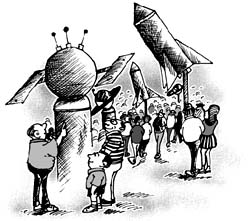Space age
 IT IS only when a disaster of the magnitude that struck Orissa takes place, does a country realise the need to perfect its scientific infrastructure. Space technology, for one, helps in planning development in such a way as to minimise the impact of such a disaster, or when it strikes, helps in planning the post-disaster affairs.
IT IS only when a disaster of the magnitude that struck Orissa takes place, does a country realise the need to perfect its scientific infrastructure. Space technology, for one, helps in planning development in such a way as to minimise the impact of such a disaster, or when it strikes, helps in planning the post-disaster affairs.
To highlight the latest in space technology, 22 countries from around the world participated in an exhibition entitled "Space '99' in New Delhi in mid-November. It was also a platform for leading international companies to get together, exchange technical knowledge, expertise, information and display the latest in space applications. The exhibition was held concurrently with the 2nd United Nations-Economic and Social Commission for Asia and the Pacific Ministerial Conference on Space Applications for Sustainable Development.
India has come a long way since the launch of Aryabhatta, the first Indian satellite in 1975.There has been no looking back since then. This was evident from the Indian participation in the exhibition. Among the Indian companies that took part in the exhibition were the Indian Space and Research Organisation (isro), National Remote Sensing Agency and Speck Systems Limited from Hyderabad.
The latest addition to the list of satellites launched by India is the Indian Remote Sensing Satellite irs-p4 (Oceansat-1), which is the "first in the series of the Indian satellites to address the oceanographic applications in a concerted manner'. Weighing 1,050 kgs, the satellite carries an ocean colour monitor (ocm) and a multifrequency scanning microwave radiometer (msmr). The ocm is a solid camera which is expected to collect data on chlorophyll concentration, detect and monitor phytoplankton blooms. It is also expected to obtain data on atmospheric aerosols and suspended sediments in the water. The msmr has the capacity to collect data on sea surface temperature, wind speed, cloud water content and water vapour content in the atmosphere.
Thus, irs-p4 will vastly augment the irs satellite system of isro which, at present, comprises four satellites
Related Content
- Affidavit filed by the Chief Wildlife Warden, Assam on feral horses in Dibru-Saikhowa National Park (DSNP), 08/05/2025
- Compliance affidavit by Tahasildar, Jaleswar, District Balasore regarding sand walls being erected in Subarnarekha, Balasore, Odisha, 22/04/2025
- Order of the National Green Tribunal regarding throwing of garbage in a drain which claimed the life of a child, Delhi, 13/01/2025
- Order of the National Green Tribunal regarding encroachment of the land marked as green area, Ghaziabad, Uttar Pradesh, 10/01/2025
- Order of the National Green Tribunal regarding endangered feral horses in Dibru-Saikhowa National Park, Assam, 16/12/2024
- Order of the National Green Tribunal regarding encroachment of 6 ponds in village Mundka, Delhi, 02/12/2024
